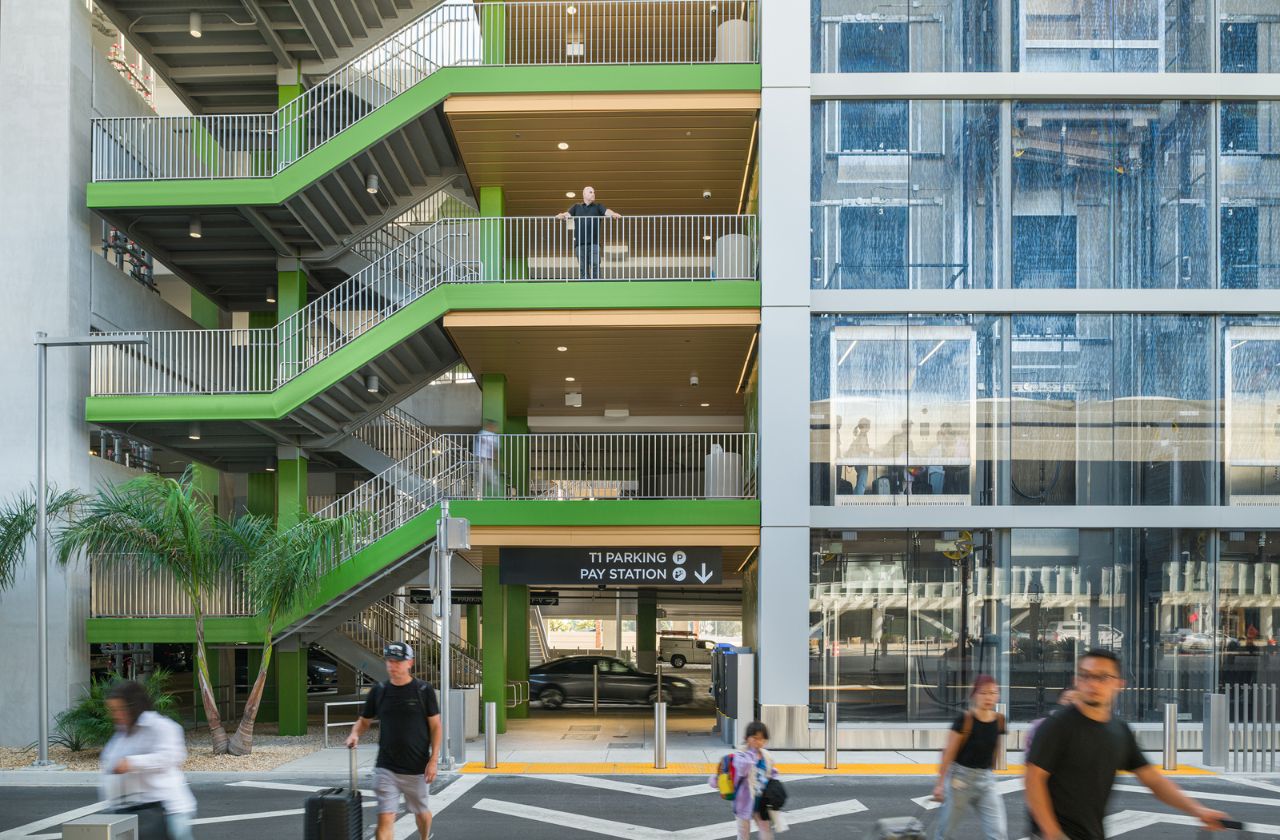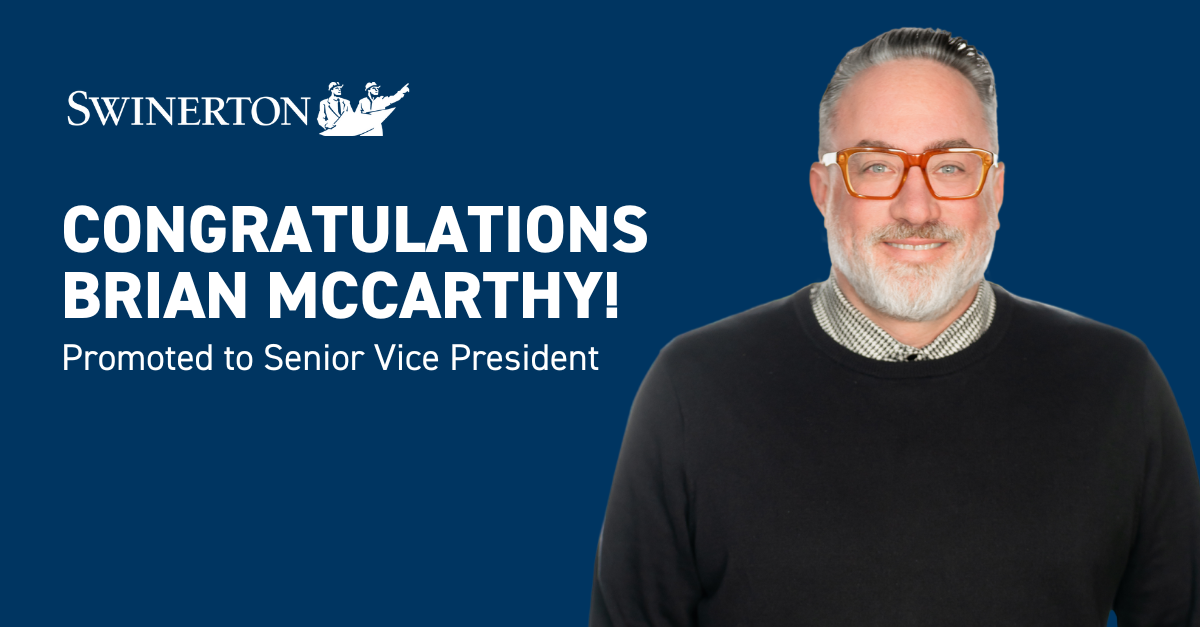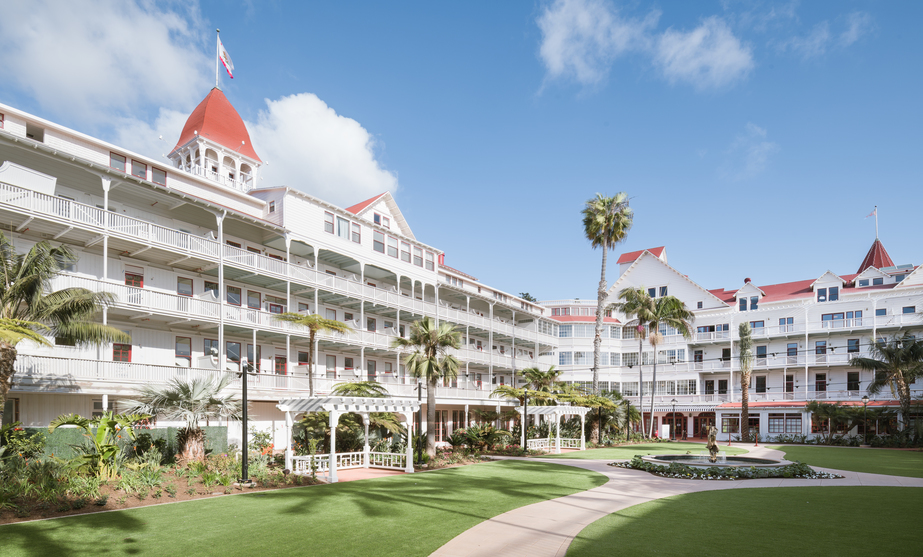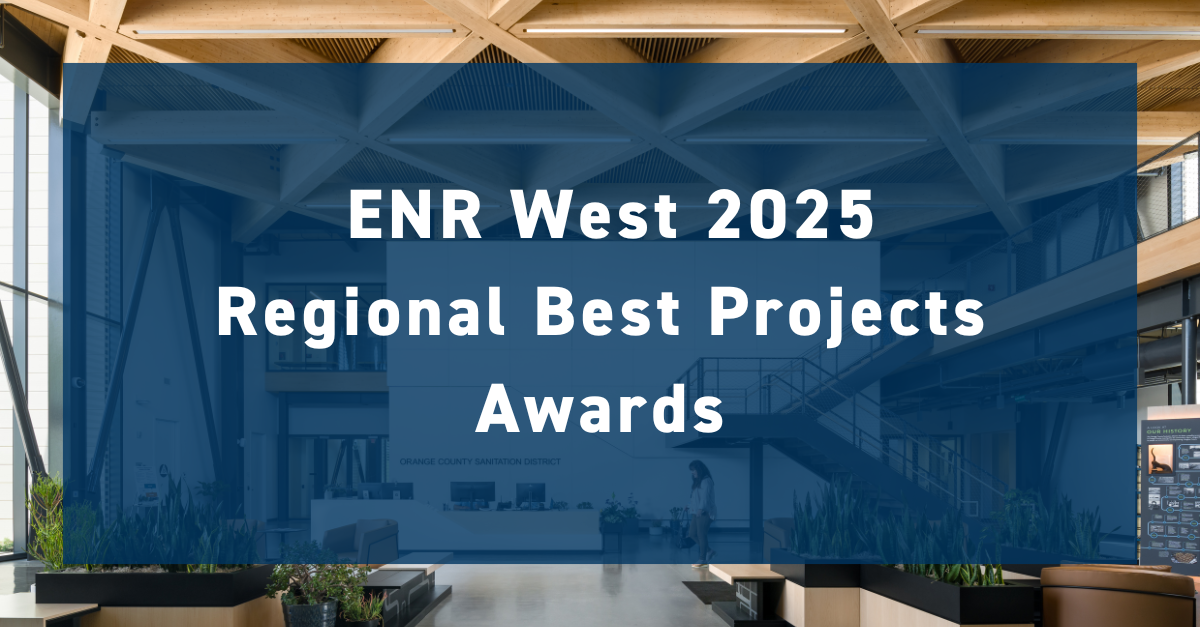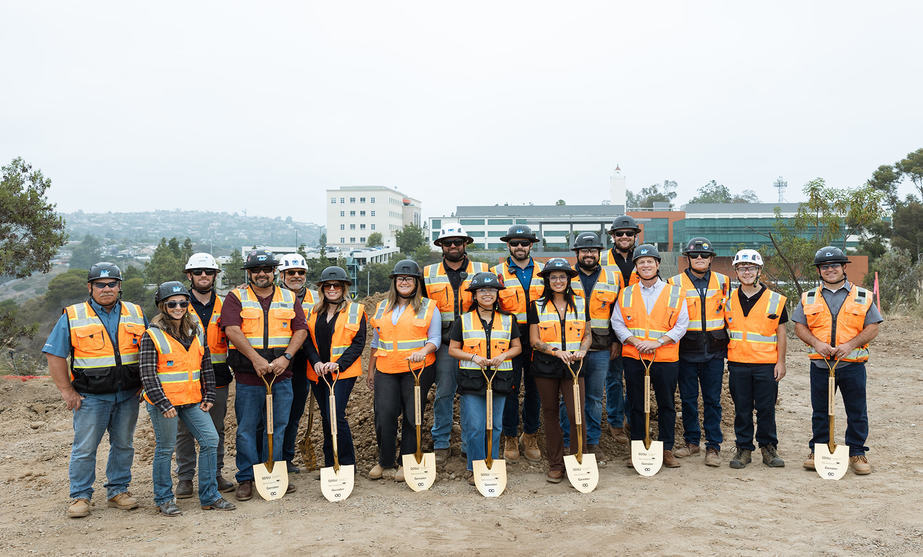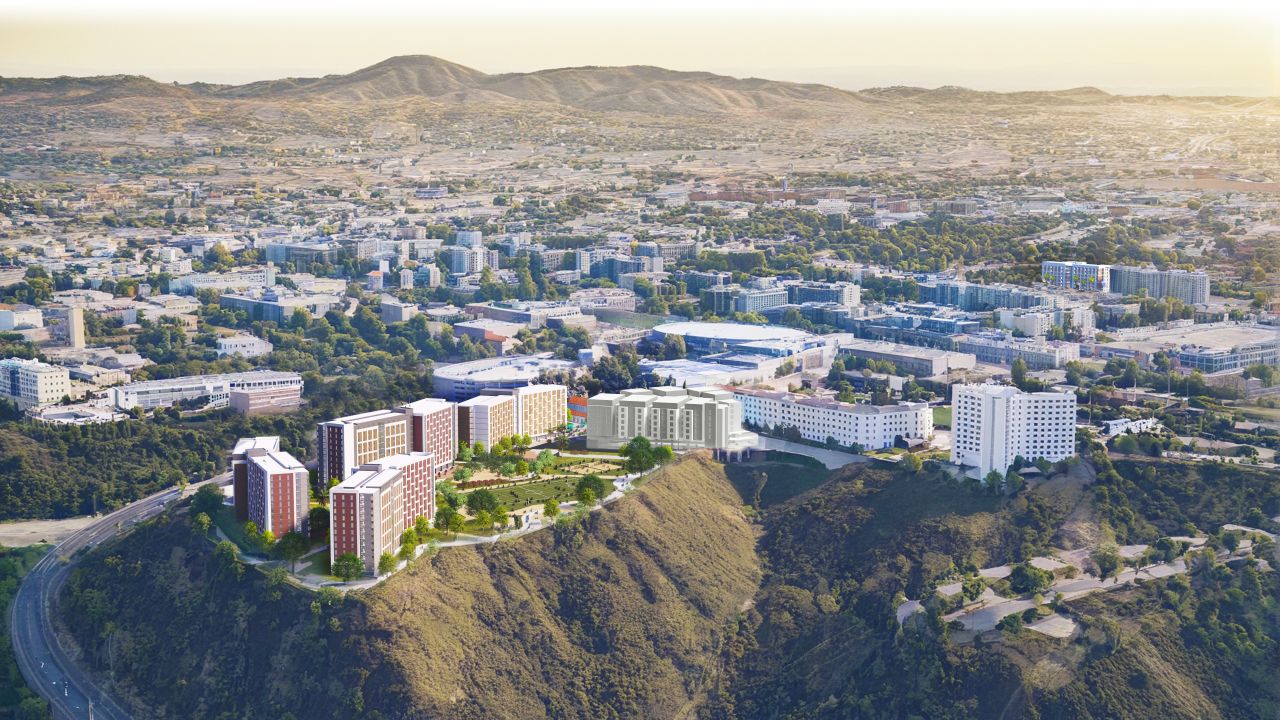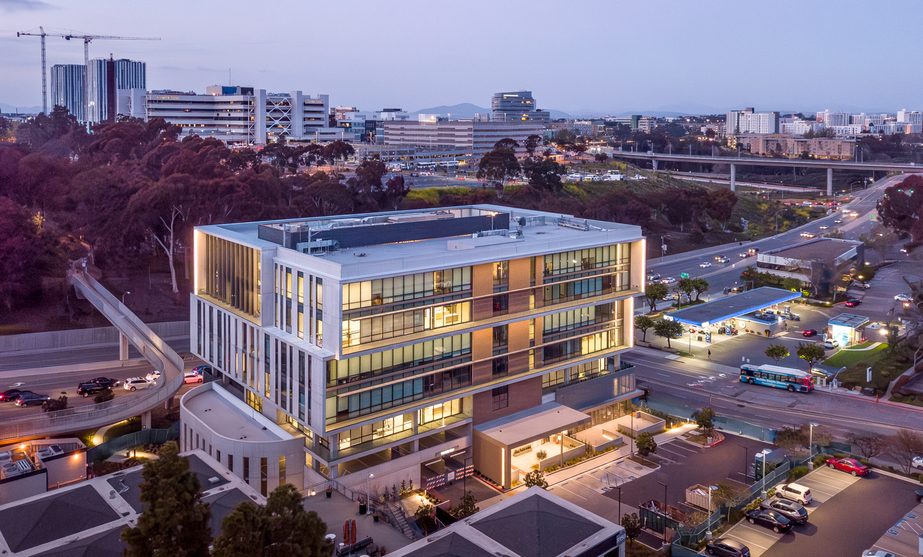Swinerton Delivers Terminal 1 Parking Plaza at San Diego International Airport
In the summer of 2025, Swinerton proudly completed design-build for the new Terminal 1 Parking Plaza at San Diego International Airport (SAN). The new Parking Plaza improves access and convenience for travelers and supports the airport’s ongoing modernization.
Working in partnership with a joint venture, Swinerton led the design-build delivery of a five-story, two-million-square-foot parking structure offering 5,230 parking stalls, located just steps from the new Terminal 1. The Parking Plaza is a key component of SAN’s transformation and was designed with both functionality and sustainability in mind.
Features for a Seamless Experience
The facility includes:
- External speed ramp and three elevator banks for efficient vertical circulation
- Advanced parking guidance system to help drivers quickly locate open stalls
- Electric vehicle (EV) charging stations, one-hour pickup spaces, and a free tire-inflation station
- Distinctive wayfinding cores with natural light and ventilation
- Color-coded sections and graphic schemes to simplify navigation
Swinerton also self-performed a significant portion of the construction, including:
- Concrete
- Expansion joints
- Doors, frames, and hardware
- Framing and drywall
- Specialty installations
Meeting San Diego’s Growing Travel Needs
The Parking Plaza was delivered in two stages. The first stage opened in August 2024, adding over 2,800 spaces. The second stage opened in September 2025, bringing the total to 5,230 spaces adjacent to Terminal 1. Combined with Terminal 2, SAN now offers nearly 8,500 close-in parking spaces.
This expansion coincides perfectly with the highly anticipated opening of the new Terminal 1, which officially welcomed travelers at the end of September 2025. Together, the new terminal and Parking Plaza provide a seamless experience, giving passengers greater accessibility and convenience as they begin or end their journeys in San Diego.
Sustainability and Safety at the Forefront
The Parking Plaza incorporates several sustainability and safety features:
- A stormwater capture and reuse system to prevent runoff into San Diego Bay
- Glass-backed elevators and open stairwells to enhance visibility
- Over 1,000 designated spots for clean vehicles, including carpool and electric/hybrid cars
- 185 EV charging ports and 20 close-in one-hour spaces for quick pickups and drop-offs
A Gateway to the New Terminal 1
Located at 3501 North Harbor Drive, the Parking Plaza is a crucial part of the airport’s broader Terminal 1 redevelopment. With the new terminal now open, the Parking Plaza enhances the overall traveler experience, streamlining access to check-in, security, and new passenger amenities.
Swinerton is honored to contribute to this milestone project, helping shape the future of travel in San Diego.
The post Swinerton Delivers Terminal 1 Parking Plaza at San Diego International Airport appeared first on Swinerton.
]]>Hotel del Coronado Commercial Restoration: Full Building Renovation
WITH GREAT PRIDE, SOHO honors one of the finest and most complex preservation achievements in San Diego history with an award to a revered national icon, the Hotel del Coronado. Designated a National Historic Landmark in 1977, the Del is not only one of the largest wood-frame buildings extant in the country but a grand and distinguished symbol of San Diego and Southern California’s architectural and cultural heritage.
This latest and final phase of the hotel’s restoration marks the most ambitious and comprehensive renewal in its 135-year history. From 2017 to 2024, the owner took on a multi-year, $155 million full-building renovation with a focused commitment to preservation; the project adhered closely to the Secretary of the Interior’s Standards for the Treatment of Historic Properties.
The architectural team studied original ink-on-linen drawings by the 1888 hotel’s architects, the Reid Brothers of Indiana, as well as photos and archival documents. These informed every detail from replicated balustrades to historically accurate paint finishes.
Following earlier People In Preservation award-winning restorations to the lobby, verandah, and historic laundry building, this phase encompassed 404 guestrooms, meeting rooms, the vast central courtyard, and all remaining facades—a total of 415,000 square feet. Systems upgrades included modernizing plumbing, electrical, HVAC, and fire safety infrastructure, all while carefully retaining the hotel’s historic integrity.
Meticulous craftsmanship defined every aspect of the work. Of the 1,620 windows and 1,770 doors, the originals were restored wherever possible. Inappropriate replacements from the past were swapped with historically accurate replicas, including five-panel wood doors, rosette corner blocks, and decorative casework.
The post Hotel del Coronado Commercial Restoration: Full Building Renovation appeared first on Swinerton.
]]>LEADERSHIP MOVE POSITIONS SWINERTON FOR GROWTH ACROSS KEY CALIFORNIA MARKETS
Brian McCarthy’s promotion reflects Swinerton’s commitment to and alignment with long-term growth and elevated client experience.
Swinerton has promoted Brian McCarthy to Senior Vice President, where he will lead the firm’s strategic growth in California’s education, healthcare and parking structures markets.
In this role, McCarthy will oversee initiatives that strengthen collaboration across Swinerton’s national geographical operations, enhance client delivery, and support the company’s goal of becoming the preferred builder in these markets. His leadership will play a key role in advancing Swinerton’s long-term strategy for market diversification and sustainable growth.
With over 25 years of construction expertise, most of it with Swinerton, McCarthy has led projects from early conception to project completion. In his previous role as Vice President in Southern California, he established standards for performance and client experience, elevating project delivery, quality and client satisfaction.
“Brian has a proven ability to lead complex projects and diverse teams with integrity,” said Ray Haj, Swinerton COO. “His expertise with our clients’ unique priorities and needs ensures we will continue delivering outstanding results across California.”
The post LEADERSHIP MOVE POSITIONS SWINERTON FOR GROWTH ACROSS KEY CALIFORNIA MARKETS appeared first on Swinerton.
]]>The hotel sector shakes off its post-Covid blues
The Southeast has been particularly active for new projects.
Over the past year, luxury and resort projects have been key drivers for AEC firms’ work within the hotel sector.
The Southeast, Southwest, and California are among the markets where firms report their strongest demand for projects that target both business and leisure travelers. Their clients’ priorities are focused on creating high-quality experiences for their guests, with an eye toward brand awareness and ROI growth.
“Hotel brands are reinvesting in their flagship properties,” notes Bob Lopez, Project Executive for the general contractor Swinerton. Brand elevation is among the factors that Lopez says are “critical” to securing long-term event contracts and attracting “high-value” clientele.
Hotel developers are looking to partner with “problem solvers” that can deliver projects on time and within budget, says Jeff Gouveia, President of Suffolk, which through its history has managed more than 100 hotel projects totaling 25 billion sf.
Lately, Suffolk has seen its steadiest demand in Florida and California, especially as coastal destinations have become increasingly popular with tourists. In Florida, its projects vary from family destinations like Great Wolf Lodge in Naples, to urban hotels like Tampa EDITION. Gaming projects are also a bright spot.
In California, Suffolk oversaw construction of Regent Santa Monica Beach, the luxury brand’s first flagship hotel in the U.S.; the Moxy + AC Hotel in Los Angeles; and the 766,000-sf, $268 million Chicken Ranch Casino Resort in Jamestown.
DLR Group has fielded “significant” demand for hotels in such areas as university and college communities, mixed-use districts, sports/lifestyle centers, and outdoor destinations. Ed Wilms, DLR’s Global Hospitality Leader and Senior Principal, adds that the Southeast has been “very active” in this sector, as have specific markets in Colorado, Utah, Cleveland, Chicago, and Kansas City.
However, some AEC firms caution that the hotel sector isn’t always smooth sailing. While the design engineering firm IMEG is experiencing a “fair amount” of proposal activity, design period schedules are not always predictable, with delays in starting or extended pauses between phases. Bob Winter, PE, IMEG’s Director of Hospitality, says these delays are typically the result of project financing or construction cost budgeting issues.
Bill Wilhelm, President of R.D. Olson Construction, says that while his firm’s pipeline for hotel projects is “robust,” many of its clients have been acting with caution due to uncertainties about labor costs and tariffs on materials.
A mix of new builds and renos
Demand for hotel projects is typically a combination of new construction, renovation, and adaptive reuse. Olson, for example, recently completed construction on AC Hotel Pasadena, and expects to finalize construction on Appellation Healdsburg later this summer. It recently broke ground on an expansion of Lido House in Newport Beach, and anticipates three more groundbreakings this year.
Much of DLR Group’s recent work in this sector, says Wilms, has consisted of major new builds either starting or resuming after being on pause the past several years. Winter says IMEG’s “significant wins” so far this year have been a mix of new construction and major renovation work. IMEG also tapped into the adaptive reuse market with recent projects like the $60 million conversion of a former YMCA in St. Louis into Museum 21C, a 10-story, 200,000-ft boutique hotel.
Swinerton led the transformation of the 137-year-old Hotel Del Coronado in San Diego that focused on historic restoration and modern upgrades. Lopez says this project included the interior demolition of the hotel’s Victorian Building and the reconfiguration of 337 guestrooms into 404. The hotel’s Garden Courtyard was also rebuilt, with its fountain and bronze statue restored.
Last February, Chicago-based developer and construction manager Keystone Group, working with a design team made up of OVAS Design, Ratio Architects, and Circle Design, completed construction of InterContinental Hotel Indianapolis, a $121 million transformation of that city’s century-old Illinois Building into a 170-key luxury hotel. The 12-story hotel includes Indianapolis’ only Penthouse Suite.
The post The hotel sector shakes off its post-Covid blues appeared first on Swinerton.
]]>Southern California Contractor of the Year: Winning Strategies Pay Off for Swinerton
Employee ownership, market diversity and a focus on sustainability drive success for ENR West’s Southern California Contractor of the Year
There are multiple strategies that have bolstered Concord, Calif.-based Swinerton’s regional performance over the last several years, helping its regional revenue climb nearly $1 billion year over year to reach $3.8 billion in 2024. Among them are maintaining a diverse project portfolio and offering specialized market expertise, which all combined to send the firm to the No. 1 spot on the annual Top Contractors list for the six-state West region.
The efforts and success have earned Swinerton ENR West Southern California Contractor of the Year honors.
“Construction is a lagging industry, so the jobs that we put in place in 2024 we would have won in 2022 or 2023. But really it’s been a strategy of diversity in markets,” says David Cramp, Swinerton’s director of SoCal education markets. “So when one market does slow down, we’re not trying to get into some new market, we’re already there, and we’re ready to capitalize on any markets that are expanding, such as the public works projects that are happening now.”
In recent years, the contractor has been focused on public works projects along the West Coast and building its corral of market experts in each geographic division to boost its presence in key sectors such as education, aviation and health care.
A focus on building and maintaining strong relationships has paid off as well, with about 75% of its work coming from repeat clients.
“Since interest rates were higher over the last couple of years, the private markets slowed down, so you’re not seeing as many high-rises, but the public market has picked up significantly,” Cramp says. “So, airports, libraries, civic projects and schools. There were a lot of bonds passed in California in the last November election—I think $40 billion just in California for K-12.”
With the 2028 Olympics fast approaching, many of the region’s airports are on the upgrade path, as are the state’s hospitals, which are racing to meet new earthquake requirements by mid-2026.
“Our teams have done a tremendous job of securing notable and fully funded projects in the aviation, education, health care, public, civic and interiors market sectors,” adds Lia Tatevosian, senior vice president and region manager for Southern California and Hawaii.
Some recent major Southern California completed projects include the County of Orange Civic Center, County Administration North, a 416,664-sq-ft, three-story project delivered under a P3 model, and the $225-million Compton High School, a 223,650-sq-ft campus that features a 36,000-sq-ft gym building and a 41,000-sq-ft performing arts center.
“I’m proud of all our wins, but especially excited about our intentional efforts to secure and deliver collaborative design-build projects such as San Diego State University Evolve Student Housing, Long Beach City College Liberal Arts Campus Student Housing and Chaffey College Library Learning Commons,” Tatevosian adds.
Among those projects wrapping up in 2025 were the Long Beach Airport Terminal Renovations and County of Riverside, Riverside Franklin Adult Residential Facility, on which Dr. Matthew Chang, director of Riverside University Health System-Behavioral Health, noted Swinerton’s commitment to fundamental design principles, flexibility and solutions-driven collaboration.
“The entire team operated with trust, transparency and exceptional communication, even when the county of Riverside requested to accelerate the timeline,” Chang recalls. “The team accommodated our needs and moved the project timeline up by one month, allowing us to meet our occupancy goals. For this, we are very grateful.”
Swinerton’s regional upswing has also coincided with its recent investments into mass timber, among other sustainable innovation initiatives such as electric vehicle programs, Tatevosian says. The firm is helping clients leverage mass timber to deliver projects faster and at a lower cost and environmental impact compared with traditional concrete and steel through its investment in full-service mass timber design, fabrication and construction affiliate Timberlab. That has allowed Swinerton to expand the supply chain for mass timber both regionally and nationally—and it’s continuing to expand those offerings.
The Orange County Sanitation District Headquarters, recently named Best Government/Public Building in ENR
West’s 2025 Best Projects contest, is the largest mass timber project Swinerton has completed in Southern California to date. This three-story, 109,000-sq-ft office building is designed to achieve both LEED Gold and net-zero energy certification.
Another differentiator is Swinerton’s self-perform workforce, which executes various trades from concrete to drywall, millwork, doors, frames, hardware specialties and demolition.
To keep these ranks full, the company regularly recruits from local community colleges to encourage young people to come into the trades as early as possible. The firm is also developing its workforce through the trades with a dedicated training program that is funneling foremen into management, Cramp says.
“We have a very large outreach program for interns too. In Southern California, we had 70 interns alone, which is great,” he adds. “Getting people to know Swinerton and getting us to know the internship population is really helpful. It’s very competitive, but that helps a lot.”
Cramp believes Swinerton’s biggest key to success is its 100% employee ownership.
“We’ve been like that for more than 30 years, and it really motivates people to take ownership in the company and in the work that they do, and so ultimately it comes down to people,” he says. “We’re a service organization, and there’s a lot that can be said [about that], but we have a great culture that values both our employees and our clients.”
The post Southern California Contractor of the Year: Winning Strategies Pay Off for Swinerton appeared first on Swinerton.
]]>Swinerton Celebrates ENR West 2025 Regional Best Projects Awards
ENR West is pleased to announce the winners for the 2025 Regional Best Projects competition in the Northern California and Southern California subregions!
After several weeks of hard work, an independent group of AEC experts reviewed 145 projects from across California, Nevada and Hawaii and selected 30 Best Projects and 36 Awards of Merit. The Northern California subregion includes northern Nevada and Hawaii while the Southern California subregion includes southern Nevada.
An Outstanding Collection of Achievements
Swinerton’s projects were highlighted among the best, securing awards in both the Best Healtchare and Best Renovation/Restoration categories. Here is a look at the honors we received:
Best Healthcare: UCSF Health Peninsula Outpatient Center, Burlingame, CA
Best Government/Public Building: Orange County Sanitation District Headquarters, Fountain Valley, CA
Best Interior/Tenant Improvement: A&J El Monte Training Facility Tenant Improvement, El Monte, CA
Best Office/Retail/Mixed-Use: 8980 Villa La Jolla Drive, San Diego, CA
Best Renovation/Restoration: Hotel Del Coronado Victorian Building Renovation, Coronado, CA
The post Swinerton Celebrates ENR West 2025 Regional Best Projects Awards appeared first on Swinerton.
]]>New SDSU Housing Development is a Record Breaker
Swinerton has started construction of what will be the largest student housing project in SDSU’s history. Rendering courtesy of Swinerton
Swinerton’s San Diego Division, in partnership with Gensler, is building a student housing development – Evolve – connected to San Diego State University’s main campus that will have more than 3,640 beds.
“Evolve is a landmark project for Swinerton, not just because of its scale, but because of what it represents,” said Swinerton Operations Manager Liz Hawkins.
“It’s the largest student housing development in SDSU’s history and one of the most ambitious in the CSU (California State University) system,” Hawkins said. “For us, it’s about more than construction. It’s about helping SDSU shape the future of affordable, accessible student housing in San Diego.”
Anticipated Completion of ‘Phased’ Project in 2030.
Student housing is typically measured in the number of beds it provides rather than the number of apartments, because students normally have separate bedrooms, but share living spaces such as kitchens and lounges.
In all, Evolve will include six buildings
“It’s a phased-delivery type of project,” Hawkins said.
Initial construction of Evolve will include two buildings of student housing – Tarastec and University Towers East – and a two-story community center of about 20,000 square feet, Templo del Sol.
Construction of the nine-story Tarastec and the two-story Templo del Sol began earlier this summer on the west side of SDU’s main campus near 55th Street and Aztec Circle Drive. Designed for first year and sophomore students, Tarastec will have 650 beds and is expected to be open in the fall of 2026, as is Templo del Sol.
Tarastec and Templo del Sol will replace the existing Tarastec Apartments, the International Student Center and the passport office.
The post New SDSU Housing Development is a Record Breaker appeared first on Swinerton.
]]>Swinerton to Lead Design-Build Student Housing Project at San Diego State University
The multi-phase student housing project will provide new traditional-style residence hall and suite- and apartment-style housing to help meet the significant existing student demand for cost-effective housing.
Swinerton’s?San Diego Division is proud to announce its design-build role for?San Diego State University’s?(SDSU)?Evolve Student Housing project—the largest student housing project in?San Diego State?history. In partnership with architectural firm Gensler, the initiative will deliver over 3,640 net new student beds and a centralized community center.
The project marks a major milestone for Swinerton in a longstanding relationship built with SDSU over the past decade, which includes over 20 projects completed on the campus. Evolve is designed to tackle?San Diego’s?urgent need for affordable student housing by delivering six new buildings—five residence towers and one amenity building consisting of dining, conference space, and other support services.
“This project is a testament to the longstanding relationship we’ve developed at SDSU,” said?Monika Iannone, senior project manager at Swinerton. “We are combining our knowledge of the campus with our expertise in multi-family residential to deliver a student-centered environment where affordability, community, and academic success intersect. Our team is honored to be leading the charge on Evolve and proud to be part of this historic expansion.”
San Diego?is in the top 10 U.S. metro areas with the highest share of?million-dollar home listings—nearly five times higher than the?national figure?(9.3%). As housing costs continue to rise, SDSU is taking steps to ensure students have access to on-campus living.
“Access to safe, affordable housing is fundamental to student success,” said?Adela de la Torre, president of SDSU. “The SDSU Evolve project is not just a housing development—it’s a commitment to our students’ well-being, sense of belonging, connection to campus life, and their academic achievement. We’re excited to move this project forward.”
The first phase of construction began in?May 2025?and includes:
- Tarastec: A suite-style residential hall designed for first-year or sophomore students based on demand. The building will offer double occupancy room types. Construction on Tarastec began in the summer of 2025, adding approximately 650 beds to SDSU’s on-campus housing. Swinerton’s accelerated construction schedule is targeting completion of this building for student move-in beginning fall 2026.
Tarastec and?Templo del Sol?will be located on the west side of SDSU near 55th Street, and Aztec Circle Drive. University Towers East will be located next to the current University Towers on Montezuma Road. Swinerton’s ability to deliver this project on an accelerated schedule is a testament to SDSU’s commitment to supporting this venture.
The project has received enthusiastic support from the?California State University?Board of Trustees, the?City of San Diego, and regional stakeholders. The Evolve project reinforces Swinerton’s deep commitment to mission-aligned infrastructure that supports communities and long-term public outcomes, especially given a nearly?60% increase?in student housing costs over the past decade.
The post Swinerton to Lead Design-Build Student Housing Project at San Diego State University appeared first on Swinerton.
]]>PUSHING THE BUILDING ENVELOPE
The La Jolla Innovation Center stands as a modern masterpiece of concrete innovation, pushing the boundaries of the utilitarian building material into new sustainable and aesthetic heights.
Delivered through one of the first Public-Private Partnership (P3) agreements in San Diego, the revolutionary 198,000-square-foot La Jolla Innovation Center spans seven stories. Five levels are dedicated to office and educational spaces, and are supported by a ground-floor café, extensive landscape and hardscape improvements, and four levels of above- and below-grade parking.
Strong Commitment to Design and Functionality
The conventional cast-in-place concrete structure prominently features Type IL concrete to achieve its modern architectural concrete aesthetic with fair-faced and board formed finishes throughout. The owner, GPI Companies, sought a “high-quality fa?ade” that could also achieve LEED Silver certification, prompting architect Gensler to express the concrete frame as an architectural feature of the project. Combined with strategically located sunshade systems, the concrete’s inherent thermal mass reduces day-time cooling needs, contributing to the building’s overall energy efficiency. The use of concrete as a building finish also translates to reduced maintenance and lifecycle costs for the owner as compared to other finish systems.
certification, prompting architect Gensler to express the concrete frame as an architectural feature of the project. Combined with strategically located sunshade systems, the concrete’s inherent thermal mass reduces day-time cooling needs, contributing to the building’s overall energy efficiency. The use of concrete as a building finish also translates to reduced maintenance and lifecycle costs for the owner as compared to other finish systems.
However, achieving the design intent was no easy feat. Swinerton served as the general contractor on the project, and also self-performed the extensive concrete scope of work. The requirement for exposed concrete and Type IL cement presented Swinerton with a host of challenges, as the various structural design elements called for mixes with 4,000, 5,000, 6,000, and 7,000 PSI—which increased the chances for variation in color due to the variation in cement and water content from one mix to the next. This would have undercut the building’s clean, modern, and sophisticated design.
To achieve the required as-cast, Class A architectural concrete finishes, Swinerton’s team developed a series of on-site, full-scale mockups. The goal was to maintain consistent color with minimal mottling or paste loss. Multiple specialized concrete mixes, including a self-consolidating concrete (SCC) and an unprecedented 7,000 PSI Type IL deck mix, were developed to achieve the ambitious design goals and maximize the albedo, or light reflectance, of the exposed concrete surfaces of the structure.
The project design also called for both fair-faced and board formed finishes throughout. Swinerton opted to utilize location-specific gang wall forms dedicated to each core or shear wall within the project. Forms were double-sheeted and back-screwed to reduce the appearance of any hardware in the finish and to maximize watertightness of the forms. Furthermore, to negate the appearance of color changes, the team modeled and sequenced construction to avoid introducing construction joints in exterior exposed conditions and gave preference to hidden keyed joints instead, which help to hide variations in mixes from one assembly to the next.
Leading the Industry with Seamless Concrete Expertise
In addition to the architectural concrete fa?ade, the building’s foundation posed challenges for Swinerton’s concrete team. The structure’s proximity to city easements, utilities, and low soil bearing values had pushed the design team toward a 54” thick mat foundation system as opposed to a traditional localized foundation system with over-excavation and slurry infill at the unsuitable soil interface. This allowed the parking to extend an additional level below ground, and reduced potentially higher construction cost premiums and avoiding interference with the easements. To assist in the project’s sustainability goals, Swinerton worked with concrete material supplier Cemex on a high cement replacement mix utilizing 60% slag for the project’s over 4,000-cubic-yard mat foundation.
The final building boasts more than 110,000-square-feet of leasable square feet with soaring 13-foot ceilings. The convenient location and cutting-edge design maximize versatility for tenant needs, with University of California San Diego already planning on housing several programs for its Health Sciences and Division of Extended Studies. Swinerton’s innovative concrete approach achieved the design team’s intent of a flexible and versatile concrete superstructure that maximizes natural daylighting, provides an aesthetic, high-quality fa?ade, and also met tight budget and sustainability requirements.
La Jolla Innovation Center stands as a hallmark of innovation and a testament to the power of leveraging self-perform concrete expertise on a highly technical, yet highly impactful project. The project went on to win an outstanding concrete project award from the American Concrete Institute (ACI), San Diego chapter.
The post PUSHING THE BUILDING ENVELOPE appeared first on Swinerton.
]]>Safety Story: Josh Marjanovich
In honor of Safety Week, we sat down with Swinerton employees to find out what safety means to them.
Josh Marjanovich is a Field Operations Manager in the San Diego division. Josh shares why safety is important, the steps for effective preventative practices, innovative ways to reach out to Craft, the influence of culture, and how it all comes down to basics.
Safety Q&A
This year’s Construction Safety Week theme is “All In Together: Plan, Own, Commit.” How do you personally put safety into action each day?
Our goal on our jobsites to make sure everyone goes home at the end of the day. We come to work for ourselves and our loved ones, and we put safety first to ensure everyone that steps foot onto our sites leaves without incident, to enjoy what they work so hard to provide.
Please share how Swinerton’s proactive safety measures and planning have contributed to successful project outcomes. What preventative practices have been most effective??
Pre-planning of work is critical to the safe and successful outcome of any project. Think through the plan, review the plan with those involved, and execute.
What safety innovation or improvement are you most proud to have contributed to at Swinerton?
I am proud to be a part of our Roaming Craft All-Hands Safety Meetings. This is something San Diego started about two years ago. Every division has their bi-monthly safety meetings attended by Admin and Supervisors but not attended by our Craft. Since our Craft are the ones putting work in place and getting things done, we felt it was important to connect with them in the field and share a similar outline as the Division Safety Meeting. These meetings are once a month, and the jobsite is selected by the field leaders of the division. Topics reviewed are overall safety stats and how we are doing as a company, trends, tool training, communication, incident reporting and proper documentation, to name a few.
Who has been an influential mentor in your construction career, and what valuable (safety) lessons have they taught you?
A line that has always stuck with me is “Safety is a biproduct of well-planned work,” from Jeff Timm. This tells me that if we do our part and plan our work well, safety will automatically come first. When we plan our work, let’s look for the hazards, plan around them and then execute our plan.
What do you believe sets Swinerton’s safety culture apart in the construction industry? How does being part of a 100% employee-owned company influence this approach??
What sets Swinerton apart from the rest of the industry really comes down to the people. We care about our people, but we don’t just say we care – we really care. Everything we do on jobs is not to add rules or make jobs more difficult. It really comes down to making sure everyone walks off that job and goes home at the end of the day.?Being part of 100% employee-owned company influences this because we all have skin in the game. It helps us all have more of a focus on what we do and helps us all strive to be the best we can.
What message would you like to send out to your fellow employee-owners during Construction Safety Week? Any safety tips that you would like to share??
Stay focused, remember the basics, and know that everyone on a jobsite looks to the Swinerton vest as the example to follow.
The post Safety Story: Josh Marjanovich appeared first on Swinerton.
]]>